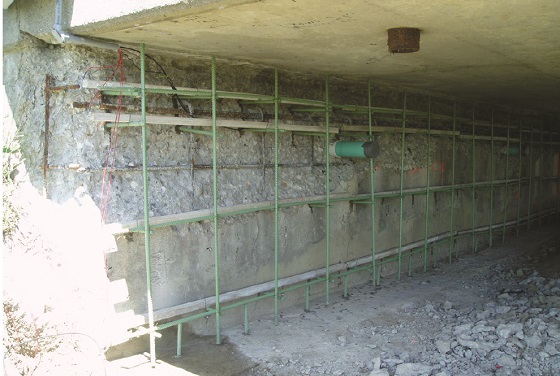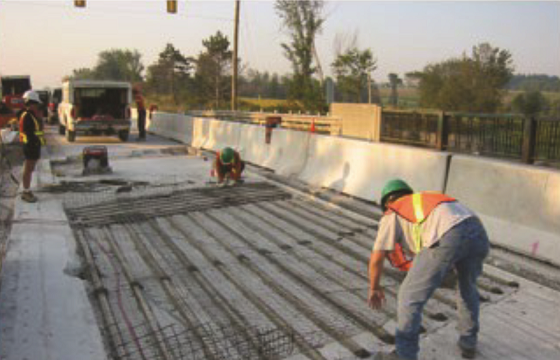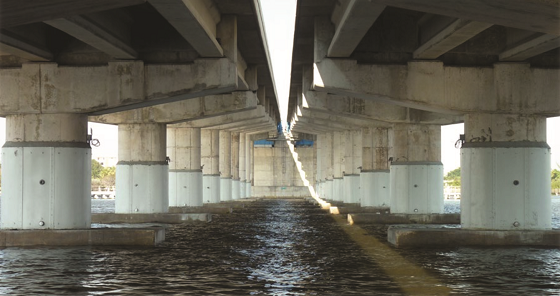This article is based on a paper presented at CORROSON 2019.1 Chloride-induced corrosion of reinforcing steel in concrete is a major problem worldwide. Chlorides can be introduced into concrete via deicing chemicals, seawater, soil, or as contaminants in the concrete mix. This can lead to pitting corrosion and concrete deterioration.
Localized repairs are often performed to address concrete corrosion damage. When a repair is completed, new corrosion sites can form just outside the repaired area and are driven by the residual chloride contamination and the difference in potential between the steel in the chloride- contaminated and chloride-free sections.2-3 When incipient anodes form, further repairs will be required. The patch repair process may be repeated several times over the remaining life of the structure.
Galvanic Cathodic Prevention
This “localized” corrosion problem can be addressed by installation of Type 1 discrete galvanic anodes around the perimeter of repairs, as shown in Figure 1. One of the oldest monitored projects where alkaliactivated, Type 1 anodes were installed in 1999 has and have been monitored for 20 years. These anodes had a high-purity zinc core cast around steel tie wires to provide a durable zinc-to-steel connection and to prevent dissimilar metal corrosion in the electrical connection between the wires and the reinforcing steel. The zinc cores were cast in high alkalinity mortar with a pH >14 to ensure the anode remains electrochemically active and does not passivate over time. After 20 years, the alkali-activated anodes remain active and continue to produce sufficient galvanic current to meet ISO 126964 cathodic prevention requirements and avoid corrosion initiation in the vicinity of the repairs.2-5
Anodes were installed 24 in (600 mm) on center along the perimeter of the repairs. Monitored parameters included anode current to the steel and anode and steel potentials. The alkali-activated anodes have produced current for 20 years and the mean current density (CD) delivered by the anodes to the steel has remained comfortably within the 0.2 to 2.0 mA/m2 CD range suggested by ISO EN12696 for cathodic prevention over the entire period. Cathodic prevention current generates alkali at the surface of the steel, which has resulted in passivation of the steel over the last 20 years even though the current may not be sufficient to meet the NACE 100 mV cathodic protection (CP) polarization criteria.6
Galvanic Cathodic Protection Case Studies
Historically, many practitioners believed CP of reinforced concrete structures required an impressed current power supply to provide enough current to protect the reinforcing steel. This is no longer the case as properly designed galvanic encasements using high output, long life, distributed alkali-activated galvanic anodes can provide sufficient CD to polarize the reinforcing steel and meet NACE CP criteria for many years. Long-term CP requires the galvanic anodes to remain electrochemically active and the electrical connections between the zinc and the steel to remain intact over the desired service life. Laboratory tests are good for verifying short-term performance. Long-term performance of galvanic CP systems is best verified by monitoring systems installed on real structures over time.
Long-term galvanic CP has been provided to bridge abutments, decks, and columns in the following case studies:
• Ohio Department of Transportation (DOT) Bridge Substructure
• Ontario Ministry of Transportation (MTO) Bridge Deck
• New York State DOT Marine Columns (Tidal/Splash Zone)
• Florida DOT Marine Substructures (Above Tidal Zone)
Ohio DOT Substructure
This Ohio DOT bridge substructure repair project was completed in July 2005 with encasement of galvanic anodes. As shown in Figure 2, the repair included removal of concrete delaminations and refacing of multiple bridge abutments with alkali-activated distributed galvanic anodes designed to provide CP to the steel in the entire abutment.
The Ohio DOT technology evaluation program included installation of dataloggers with shunts to monitor current and thermocouples for measuring temperature. The reinforcing remained in contact with chloride-contaminated concrete and the design intent was to provide long-term galvanic CP.

Galvanic current can be integrated over time to calculate the quantity of zinc that has been consumed. The calculated anode life for this system based on an anode utilization factor of 0.8 and an anode efficiency factor of 0.9 is ~35 years. This calculation is probably conservative as the anode consumption rate slows with age as the steel becomes more passive.
The following NACE SP02166 CP criteria have been met for 13 years:
• Cathodic polarization exceeds 100 mV.
• The polarized instant-off potentials are more negative than –850 mV vs. copper/copper sulfate (Cu/CuSO4) electrode (CSE).
The abutment remains in very good condition and this rehabilitation technique is now commonly used by Ohio DOT and other states to extend the service life of bridge substructures. Before completing this galvanic encasement, this type of abutment was being repaired every five to seven years.
Ontario MTO Bridge Deck Overlay
The bridge deck of the North Otter Creek Bridge was chloride contaminated and required repair due to long-term exposure to deicing salt. In 2003, the MTO decided to place a galvanic CP overlay on the bridge deck.
The bridge deck was prepared by milling off a portion of the existing concrete cover. Since most of the reinforcing steel would remain in chloride-contaminated concrete, a “distributed” galvanic CP overlay was installed. The galvanic anodes consisted of a zinc core encased in a low-resistivity alkali-activated mortar shell and were prefabricated to fit the dimensions of the deck. A carbon fiber grid was installed over the anodes (Figure 3) to reduce shrinkage cracking in the 2.5-in (60-mm) thick silica fume concrete deck overlay.

The bridge deck has been monitored since 2003 and remains in good physical condition. Data provided in Table 1 confirms that the galvanic CP overlay is providing over 100 mV polarization and is meeting the NACE SP0216 galvanic CP standard criteria even though a bridge deck waterproofing system was installed on top of the silica fume concrete overlay, keeping the anodes in a relatively dry environment.
New York State DOT Marine Columns (Splash Zone)
In 2006, New York State DOT completed a project on the Robert Moses Causeway to Long Island, New York, USA. The project included installation of galvanic CP jackets to protect the tidal and splash zone of 764 columns.
Monitored jackets have met CP criteria by providing >100 mV polarization. New York State DOT specified a 40-year design life for the column jackets. Service life calculations based on data from a few monitored jackets predict that the system contains enough zinc to last over 70 years.
Florida DOT Marine Columns (Above Splash Zone)
Two Florida DOT marine bridges, one located in south Florida and the other in the Florida Keys, were suffering from corrosion due to chloride contamination from storm surges and atmospheric exposure.
Florida DOT has utilized other corrosion protection options, such as arcsprayed zinc and zinc mesh jackets on this type of structure in the past with limited success. These projects utilized distributed alkali-activated galvanic anodes installed inside stay-in-place forms. The stay-inp-lace forms may be fiberglass or modular polyvinyl chloride (PVC).
Modular interlocking PVC panels provide improved bond to the cementitious grout fill and are easily adjusted on site to meet project requirements.
As with all Florida DOT projects, monitoring provisions were provided when the column jackets were installed, such that the long-term performance of the galvanic CP system could be verified. Figure 4 shows an overview of the installation.

The alkali-activated galvanic CP jackets are being monitored by Florida DOT. Monitoring parameters include potentials, current, polarization, and calculated anode service life. Due to the number of monitored columns, the raw data is too voluminous to present herein. The alkali-activated galvanic jacket systems have met or exceeded the NACE SP0216 CP criteria by polarizing the reinforcing steel more than 100 mV.
Conclusions
1. Alkali-activated Type 1A discrete galvanic anodes can significantly extend the service life of concrete repairs.
a. Anodes installed in the 1990s remain active and have provided corrosion prevention (cathodic prevention) CD to reinforcing steel for 20 years. CP current has resulted in passivation of the steel over time.
b. Examination of anodes removed from the structure verify there is enough zinc remaining to last 25 to 30 years.
2. Galvanic CP systems utilizing alkali-activated anodes can be designed to remain active and produce sufficient current to meet NACE CP criteria for 20 to 40 years in a range of environments including:
• Bridge substructures in temperate, deicing salt environments
• Bridge decks in temperate, deicing salt environments
• Bridge piles in marine tidal/splash zones
• Bridge columns in tropical, marine environments above the tidal zone
References
1 D. Whitmore, M. Miltenberger, “Galvanic Cathodic Protection of Corroded Reinforced Concrete Structures,” CORROSION 2019, paper no. C2019-13085 (Houston, TX: NACE International, 2019).
2 G. Sergi, C.L. Page, “Sacrificial Anodes for Cathodic Protection of Reinforcing Steel Around Patch Repairs Applied to Chloride-Contaminated Concrete,” European Corrosion Congress Proceedings, Aachen, Germany, held August 30 to September 2, 1999 (Frankfurt, Germany: DECHEMA e.V., 1999).
3 G. Sergi, D. Simpson, J. Potter, “Long-Term Performance and Versatility of Zinc Sacrificial Anodes for Control of Reinforcement Corrosion,” European Corrosion Congress Proceedings, Edinburgh, Scotland, U.K., held September 7-11, 2008 (Frankfurt, Germany: DECHEMA e.V., 1999).
4 ISO 12696:2012(E), “Cathodic Protection of Steel in Concrete” (Geneva, Switzerland: ISO, 2012).
5 G. Sergi, “Ten-Year Results of Galvanic Sacrificial Anodes in Steel Reinforced Concrete,” Mater. Corros. 62, 2 (2011): pp. 98-104.
6 NACE SP0216-2016, “Sacrificial Cathodic Protection of Reinforcing Steel in Atmospherically Exposed Concrete Structures” (Houston, TX: NACE, 2016) .